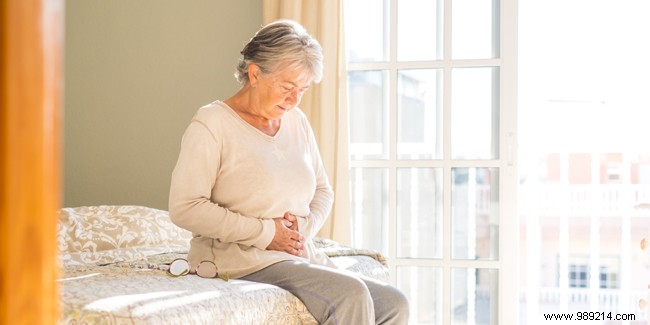
We call diverticulitis the inflammation or infection of a part of the colon where there are diverticula, kinds of growths that form on this organ. Diverticula, and in particular their inflammation, are more common in people aged 60 and over, and very common after 80. Diverticulitis causes characteristic pain in the left and lower part of the abdomen, sometimes nausea or fever. These inflammations are generally treated very well, but it is sometimes necessary to resort to surgery to remove the part of the infected colon, in particular in subjects who experience recurrent diverticulitis.
We speak of diverticulitis to designate an inflammation or infection that occurs in one or more diverticula. These are abnormal cavities, in the form of pockets, which form on a hollow organ, such as the colon, the intestine, the esophagus, or the stomach, and which communicate with the latter.
Concretely, these diverticula have the form of small growths, sorts of small hernias, which are located on the outer surface of the organ. When they are placed on the colon, most often in its part connected with the rectum, it is called colonic diverticulosis.
Diverticulitis is therefore the inflammatory and infectious disease of the diverticula formed on part of the colon. It is usually localized to a specific location of the organ. This complication affects about a quarter of people who suffer from diverticulosis.
A person can suffer once in their life from diverticulitis after it has been treated. However, in 30% of cases, a second attack, or even more, occurs. In up to 80% of these cases, diverticulitis may become a recurring problem.
Diverticula are anatomical abnormalities that are more common with age due to the greater fragility of the digestive system or when one has a diet low in fiber. According to the public health information service of the Ministry of Solidarity and Health, diverticulosis is rare before the age of 30. On the other hand, 30% of people aged 60 and over suffer from it, and even 60% of people over 80.
The organization also indicates that the health problems linked to the presence of diverticula are observed mainly in industrialized countries where their occurrence is favored "by years of bad lifestyle habits:diet low in fiber, excess of sugary foods and sedentariness".
In addition to age, having a diet low in fiber, in particular so-called "soluble" fiber, is indeed a risk factor for diverticulosis, especially that of the colon. Eating too much sugar and not having regular physical activity also increase this risk. These factors are also most often the cause of a problem of chronic constipation which also promotes diverticulosis.
This is why it is advisable to prevent diverticulosis and diverticulitis to have a balanced diet, in particular composed of fibers from, for example, whole grains, and low in sugars. In general, it is also necessary to favor foods that avoid constipation.
When diverticula placed on the bowel or colon are not subject to inflammation or infection, they usually go unnoticed. Thus, three quarters of those affected have no symptoms.
However, in the presence of diverticulitis, that is to say inflammation or infection of these diverticula, the symptoms are much more obvious to recognize. Diverticulitis is most often manifested (90% of cases) by pain in the left and lower part of the abdomen, pain often compared to that which occurs during appendicitis. Half of people with this infection also have a fever. Others experience bloating, nausea, or may vomit.
A person with diverticulitis may also experience bowel problems, mainly constipation, and their white blood cell count may increase.
In the case of severe symptoms, it is recommended to consult your doctor as soon as possible.
You should also know that diverticulitis can itself be accompanied by complications such as the occurrence of an abscess, perforation, fistula, narrowing of the colon, hemorrhage or peritonitis. However, these are fairly rare cases.
Most of the time, diverticulitis is easily treated because it heals on its own without doctors needing to prescribe special medication, except to calm pain and fever if necessary.
In some cases, however, especially in frail people such as the elderly for example, it is preferable to prescribe antibiotics for at least a week. Most often, the doctor also prescribes a "residue-free" diet, that is to say without fiber, so as not to leave waste in the part of the digestive tract affected by diverticulitis, while it it heals.
When the inflammation of the diverticula or diverticula placed on the colon is more severe, it is sometimes necessary to have recourse to a surgical intervention called "Hartmann's" or "sigmoidectomy". It consists, in the case of infected diverticula on the colon, in removing the last part of the colon which precedes the rectum (left and sigmoid) in order to remove all the diverticula.
Contrary to popular belief, it is not necessary to remove certain products from your diet to prevent diverticulitis. This has long been the case with regard to, for example, the consumption of nuts such as walnuts, hazelnuts, almonds, pistachios, peanuts, etc., wheat, corn or popcorn. Studies have shown that these foods do not play a particular role in the recurrence of diverticulitis.